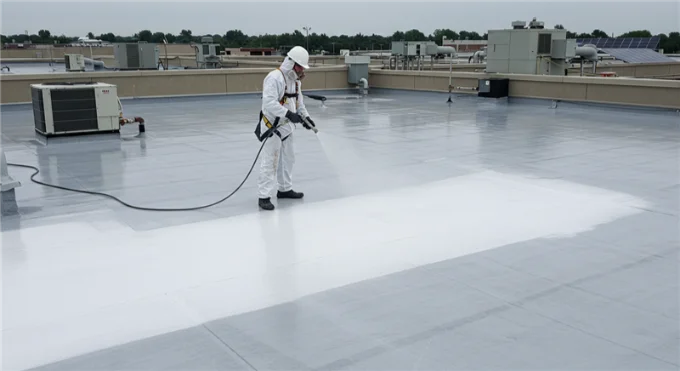
Spray foam roofing differs from traditional roofing systems in both structure and performance. It uses a liquid-applied polyurethane foam that expands into a solid, seamless barrier, providing both insulation and weather protection. Traditional systems like asphalt shingles or metal panels rely on layered, mechanical assembly that can leave gaps vulnerable to moisture and air intrusion.
In temperate and marine climates like Seattle’s, spray foam creates a continuous, monolithic seal that adapts well to variable moisture levels, while traditional systems often suffer from trapped condensation and thermal bridging.
Spray foam installation experience shows that it significantly improves thermal resistance, reduces air leakage, and lowers long-term energy costs. Field observations confirm faster application timelines and fewer disruptions for occupied buildings, making it an ideal solution for commercial insulation projects where efficiency and performance are critical.
| Feature | Spray Foam Roofing | Traditional Roofing Systems |
|---|---|---|
| Material Composition | Polyurethane foam | Asphalt, wood, metal, or tile |
| Installation Method | Sprayed directly onto roof surface | Nailed or adhered in sections |
| Seamlessness | Fully seamless | Multiple seams/joints |
| Insulation Value (R-Value) | R-6.5 to R-7 per inch | R-1 to R-4 per inch |
| Weight | Lightweight (approx. 1.5 lbs/sq.ft.) | Varies; can exceed 5 lbs/sq.ft. |
| Lifespan | 20-30 years with maintenance | 15-25 years depending on material |
| Reflectivity (Cool Roof) | High with reflective coatings | Moderate to low unless coated |
| Waterproofing | Closed-cell foam prevents leaks | Relies on underlayment and overlap |
| Energy Efficiency | High | Moderate |
| Maintenance Needs | Minimal with periodic recoating | Moderate to high |
| Regional Suitability | Performs well in Seattle’s damp climate | Susceptible to moss and moisture traps |
| Specification | Spray Foam Roofing |
|---|---|
| Foam Type | Closed-cell Polyurethane |
| Typical Thickness | 1.5–3 inches |
| Thermal Resistance | R-6.5 to R-7 per inch |
| Application Temperature Range | 50°F to 100°F |
| Curing Time | 8 to 24 hours |
| Compressive Strength | 40-60 psi |
| Water Absorption Rate | <1% |
| Wind Uplift Resistance | Meets FM Global & ASTM standards |

Crews working on occupied facilities have documented faster project completion times with spray foam, often reducing jobsite presence by 30% compared to traditional tear-off systems. The seamless application reduces risk of failure points such as flashing or fastener penetrations. This has been particularly effective in Seattle’s wet season when moisture intrusion can derail traditional installations.
Bonus Tip: Avoid applying spray foam during heavy rain or high humidity windows, as this can interfere with adhesion and curing. Use moisture meters to check deck dryness before application.
Bonus Tip: Before committing, request core samples of your current roof to evaluate compatibility with foam overlay. This can reduce full tear-off costs.
How long does spray foam roofing last?
With regular maintenance such as recoating every 10-15 years, it can last 25-30 years.
Can spray foam be applied over existing roofs?
Yes, if the existing roof is structurally sound and clean. This avoids the need for a full tear-off.
Is it safe for occupied buildings during application?
Work areas must be ventilated, but most projects allow partial occupancy due to the low disturbance method.
Does it require special maintenance?
Regular inspections and recoating are advised every decade to maintain waterproofing.
For roofing systems that perform in the Pacific Northwest climate, spray foam provides long-term reliability and measurable efficiency. Contact Cascadia Spray Foam of Seattle for technical advice or project-specific recommendations.
Phone: (425) 386-3500 Email: [email protected]
What kind of buildings benefit most from spray foam roofing?
Flat-roofed commercial, industrial, or multi-family residential structures benefit most due to energy savings and leak protection.
Can spray foam roofing be repaired or patched?
Yes. Damaged sections can be cleaned, dried, and recoated or patched with compatible foam and elastomeric coating.
How does spray foam respond to Seattle’s rainfall?
Closed-cell foam resists water absorption, and the seamless coating prevents moisture intrusion during high rainfall periods.
Is it compatible with solar panel systems?
Yes. Mounting systems can be integrated with foam roofing using reinforced adhesive plates.
Does spray foam contribute to LEED certification?
Yes. Its insulation value and energy efficiency can contribute points under LEED and other green building programs.